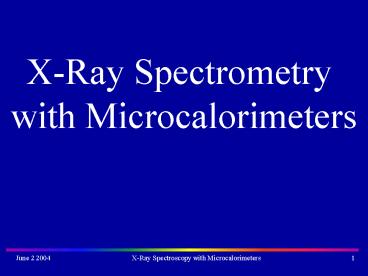XRay Spectrometry - PowerPoint PPT Presentation
1 / 29
Title:
XRay Spectrometry
Description:
(after anneal) New Microcalorimeter Design. June 2 2004. X-Ray Spectroscopy with Microcalorimeters ... (after anneal) Deep implants using silicon-on-insulator ... – PowerPoint PPT presentation
Number of Views:34
Avg rating:3.0/5.0
Title: XRay Spectrometry
1
X-Ray Spectrometry with Microcalorimeters
2
Electromagnetic Spectrum
3
(No Transcript)
4
Cassiopeia A in the Optical
and the X-Ray Bands
5
Cas A
(soft) red (medium) green (hard) blue
X-rays
6
The need for high resolution X-ray
spectroscopy Astrophysical Plasmas Simulation
of the emission from a gas at T 107 K with
normal abundances of elements. An energy
resolution of 10 eV is required to begin
serious X-ray spectroscopy and a resolution of
1 eV is required for complete plasma diagnostics
and velocity measurements.
1 eV
10 eV
100 eV
Energy (keV)
7
Energy-Selected X-ray Imaging
4-6 keV
Cassiopeia A ACIS spectrum
8
Cassiopeia A Ejecta Knots
- Temperatures are comparable 2 keV
- Si-rich knots have low ionization age (electron
density x time) - Fe-rich knots have ionization ages that are
higher by 50-100
Ar
Si
S
Ca
Ar
Fe L
Fe K
Si
S
Ca
9
Physical Conditions Through X-Ray Spectroscopy
Fe-K lines provide very clean diagnostics.
One such diagnostic excellent density-independent
temperature sensitivity in the range 107108
Kelvin.
10
The X-ray Microcalorimeter
Features high resolution, non-dispersive
spectroscopy with high quantum efficiency over K-
and L- atomic transition band.
Moseley, Mather and McCammon 1984
11
Simple Energy Resolution Argument
- dT E/C (temperature rise for E deposition)
- C Nk (N of phonons with ltkTgt)
- N C/k (fluctuation in N is the noise)
- ?N vN (Poisson
statistics) - R E/(?E) N/(?N) (resolving power)
- ?E kT vN kT v(C/k) v(kT2C)
- More carefully, ?E 2.35 ? v(kT2C)
12
Spectral Resolving Power Depends on thermometer
technology Temperature-sensitive
resistance Resolution limited by thermal
fluctuations between sensor and heat bath and
Johnson noise.
Doped semiconductor
R (ohms)
Temperature
- T operating temperature (50-100 mK)
- C heat capacity
- 2 - 4 for doped semiconductors
- 0.2 for transition edge sensors
- For both thermometer schemes a spectral
resolution of few a eV is possible!
R (ohms)
Superconducting Transition
Temperature
13
Basic requirements Low temperature Sensitive
thermometer Thermal link weak enough that the
time for restoration of the base temperature is
the slowest time constant in the system yet not
so weak that the device is made too slow to
handle the incident flux. Absorber with high
cross section yet low heat capacity
Reproducible and efficient thermalization
Types of thermometers resistive capacitive
inductive paramagnetic electron tunneling
14
Microcalorimeter Arrays
XQC Array 36 array of 0.5 ? 2 mm pixels.
15
X-Ray Quantum Calorimeter Dewar
16
Astro-E2
Astro-E2 is a powerful X-ray observatory
developed jointly by the US and Japan (Institute
of Space and Astronautical Science).
- High x-ray spectral resolution throughout energy
band where bulk of astrophysically abundant
elements exist (O - Ni) - Non-dispersive spectrometers enable imaging
spectroscopy of extended sources
- Large collecting area for high sensitivity
- Very large simultaneous bandwidth
- Complementary to Chandra and XMM-Newton X-ray
Observatories
17
Astro-E2
Focal Lengths XRS - 4.5 m XIS - 4.75 m
XRT (GSFC ISAS)
XIS (ISAS MIT)
HXD (ISAS)
GSFC/ISAS XRS
18
Astro-E2/XRS Simulation of the Centaurus Cluster
X-Ray Image
Fe-L Ne
Mg
Astro-E2 ideal for for obtaining x-ray spectra of
extended sources.
Si
O
S
Ar
Ca
Ni
19
New Microcalorimeter Design
- Developed process to make ion-implanted Si
thermistors with deeper profiles using
silicon-on-insulator wafers. - Essentially eliminated 1/f noise ? higher
resolution! - Appropriate thermal conductance achieved with
thinner Si no need to perform texturing etch to
beams to make them diffusive. - DRIE to form pixels with good mechanical
properties.
20
Deep implants using silicon-on-insulator
wafers. 625 ?m pixels
GSFC
Mn Ka1
Mn Ka2
21
(No Transcript)
22
RTS Rotating Target Source
23
motor
target wheel
24
(No Transcript)
25
(No Transcript)
26
NTD Calorimeter with Sn Absorbers
SAO Silver et al.
27
Toward higher spectral resolution and large
arrays Transition edge microcalorimeters
4.5 eV
SRON, 4.5 eV, 100 ?s time constant, 30 min
acquisition time
28
Microcalorimeter Arrays based on Mo/Au TES
Array of identical devices
Bi
Sharp photolithography
GSFC
Array of identical 150 micron devices. Soon will
make these with 250 and 400 micron mushroom
absorbers. The Bi absorbers shown are the size
of the stem in the mushroom.
29
Results from Compact TES Pixels
Paves the way for faster, more robust pixels for
the Constellation-X Mission.
Energy Resolution 2.5 eV (FWHM)
Mo/Au TES Compact pixel design (300
?m) Continuous membrane thermal isolation
Counts
Energy (keV)
GSFC
1024 pixel absorber array































